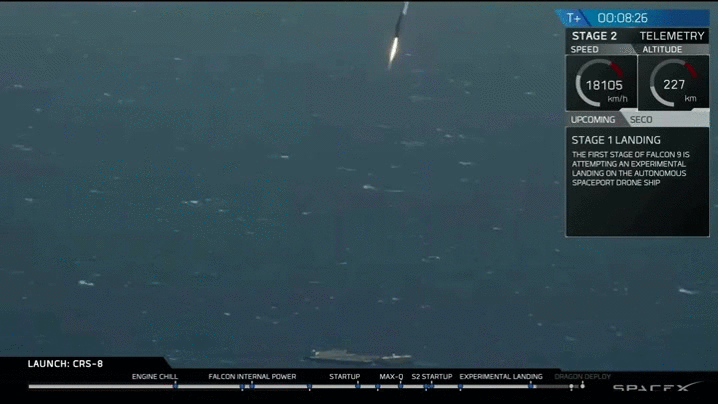SpaceX’s historic Falcon 9 landing of allows us to dream really REALLY big again.

Nick Stockton via Wired:
Today in space history, a rocket went to space. No big. But then it came back down and landed on a drone barge in the middle of the ocean.
The rocket was a Falcon 9, built by SpaceX, Elon Musk‘s commercial spaceflight company. On its own, the retropropulsion landing is a major technological accomplishment. But it means even more as a step toward reliably getting humans off of Earth—maybe even permanently. “In order for us to really open up access to space,” Musk said in a press conference shortly after the landing, “we need to achieve full and rapid reusability.”
Every time SpaceX tries to send a rocket to space and subsequently try to land it back down to earth, I want to catch it live. And I have the past few instances. It’s like watching the future of the human race unfold in front of my eyes. The past few times it sent cargo into space and tried to land on an ocean barge, the landing part wasn’t so successful.
That’s why finally nailing it this time around is so exciting: being able to reuse a $60 million rocket enhances our chances of being an interplanetary species. It reduces the cost of space flight by a magnitude, and maneuvering a 25-story tall rocket into a safe landing is a pre-requisite in sending humans to destinations literally out of this world.
While SpaceX’s business model relies on missions commissioned by NASA, other government space agencies, and commercial satellite companies, its founder Elon Musk started the company with one mission: to send mankind to Mars. Turns out it’s pretty damn difficult; it actually is rocket science after all. But more and more, especially after Falcon 9’s successful drone barge landing, it’s proving to be something that might be possible.
And I think, beyond the missions and the landings, what makes this incredibly more moving is that they are making the concept of space cool again. Such ambitious, grandiose, and technologically challenging projects give us permission to dream really really big things, no matter how (literally) unreachable they seem to be. And this kind of hellbent optimism, despite the multiple gut-wrenching setbacks, is exactly what we need as a people in order to create the future we desire.
Mistakes will be made. Risks will be met. Doubt will creep in. But a unified vision, strong execution, and an unwavering hunger to learn again and again both from what we get wrong and right is the only way to make what others thought was impossible to actually happen.
And that’s exactly what SpaceX has set out to do from the very beginning, throughout the rest of the year, and perhaps even after we reach Mars:
By the end of the year, Musk expects the company to be launching a rocket every two to three weeks, getting better data on what makes a landing successful or unsuccessful every time. “I think we’ll be successful when it becomes boring,” says Musk. That means like, airplane boring. Ultimately, a successful landing should make zero news.
For the full webcast in all its glory, watch below:
BONUS: Here’s the first time a Falcon 9 successfully landed back on land on December 21, 2015:
You can follow me on Twitter here.